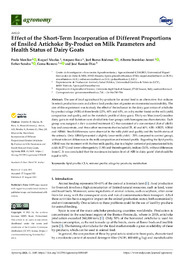Por favor, use este identificador para citar o enlazar este ítem:
https://hdl.handle.net/11000/34330
Effect of the Short-Term Incorporation of Different Proportions of Ensiled Artichoke By-Product on Milk Parameters and Health Status of Dairy Goats
Título :
Effect of the Short-Term Incorporation of Different Proportions of Ensiled Artichoke By-Product on Milk Parameters and Health Status of Dairy Goats |
Autor :
Romero Moraleda, Gema
Díaz Sánchez, José Ramón
Monllor Guerra, Paula
Muelas, Raquel 
Roca, Amparo
Bueso Ródenas, Joel
Atzori, Alberto Stanislao 
Sendra, Esther  |
Editor :
MDPI |
Departamento:
Departamentos de la UMH::Tecnología Agroalimentaria |
Fecha de publicación:
2021-08 |
URI :
https://hdl.handle.net/11000/34330 |
Resumen :
The use of local agricultural by-products for animal feed is an alternative that reduces livestock production costs and allows food production of greater environmental sustainability. The aim of this experiment was to study the effect of the inclusion in the dairy goat ration of artichoke by-product silage (ABS) at three levels (25%, 40% and 60%, on a dry matter basis) on the milk yield, composition and quality, and on the metabolic profile of dairy goats. Thirty-six Murciano-Granadina dairy goats in mid-lactation were divided into four groups with homogeneous characteristics. Each group was assigned a diet: a control treatment (C) that consisted of a conventional diet of alfalfa hay and concentrate, and three other treatments that included 25, 40 and 60% ABS: ABS25, ABS40 and ABS60. Small differences were observed in the milk yield and quality and the health status of the animals. Only ABS60 presented a slightly lower milk yield (−20% compared to control group), without relevant differences in the milk composition and mineral profile. Regarding the lipid profile, ABS40 was the treatment with the best milk quality, due to a higher content of polyunsaturated fatty acids (4.37%) and lower atherogenicity (1.90) and thrombogenicity indices (3.05), without differences from C. It was concluded that the maximum inclusion level of ABS in dairy goats’ diet should be equal to 40%.
|
Palabras clave/Materias:
lipid profile
CLA
mineral profile
silage by-products
metabolism |
Tipo de documento :
info:eu-repo/semantics/article |
Derechos de acceso:
info:eu-repo/semantics/openAccess
Attribution-NonCommercial-NoDerivatives 4.0 Internacional |
DOI :
https://doi.org/10.3390/agronomy11081649 |
Aparece en las colecciones:
Artículos Tecnología Agroalimentaria
|
 La licencia se describe como: Atribución-NonComercial-NoDerivada 4.0 Internacional.
La licencia se describe como: Atribución-NonComercial-NoDerivada 4.0 Internacional.
 La licencia se describe como: Atribución-NonComercial-NoDerivada 4.0 Internacional.
La licencia se describe como: Atribución-NonComercial-NoDerivada 4.0 Internacional.
.png)
